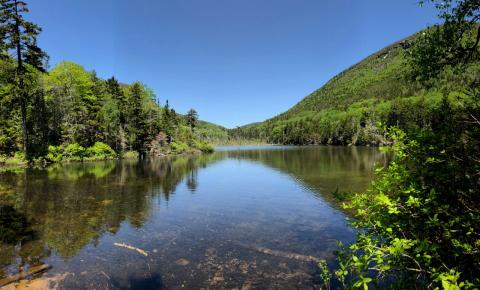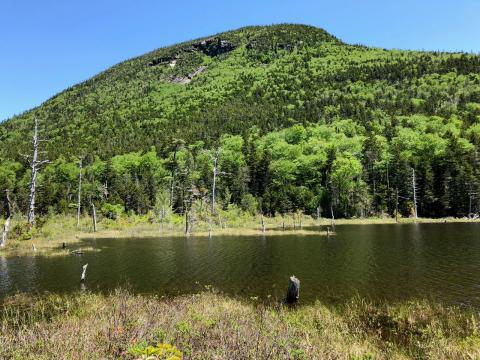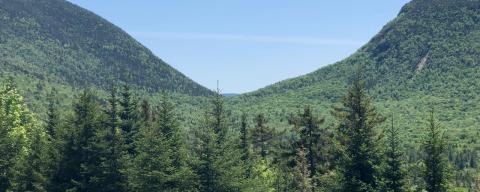Saving the Old Growth Forests of Mad River Notch - A Century Ago
In the heart of the White Mountains is a wild forest with ancient trees that escaped the heavy logging and forest fires of the early part of the 20th Century. Saved from logging by a successful citizen conservation effort in the 1920s, Mad River Notch today boasts the second-largest old-growth spruce forest in New Hampshire.
The Setting
Mad River Notch is one of New Hampshire’s most spectacular roadless notches. Located in the Unincorporated Township of Livermore in Grafton County, it sits entirely within the White Mountain National Forest. It is bounded on the west by Mount Osceola and the east by a ridge of Mount Kancamagus. Mad River Notch contains a large area of old-growth northern hardwood and spruce forest. The narrow gap between these mountains also contains the scenic Upper and Lower Greeley Ponds. The setting of this narrow notch with towering mountainsides, ponds, and the spruce forest is a favorite with hikers at any time of the year.
Mad River Notch and Greeley Ponds are the headwaters of the appropriately named Mad River. Greeley comes from Nathaniel Greeley, who established a hotel in Waterville Valley in 1831. Upper Greeley Pond is at 2,245 feet elevation and is only two acres in size. Although small, the pond is over twenty-feet deep and contains Eastern brook trout. Lower Greeley Pond is three acres in size but is only two feet in depth after being filled in over the centuries by landslides.

Upper Greeley Pond

Lower Greeley Pond
Saving Mad River Notch
In 1925, Mad River Notch and the adjacent Waterville Valley contained one of the last sizeable virgin spruce forests left in the White Mountains. A major logging operation prepared to harvest 16,000 acres in the next few years. A logging railroad would carry the logs through unspoiled Mad River Notch and then down to the mills in Lincoln, NH. The citizens of Waterville Valley and, more broadly, all of New Hampshire were alarmed at this proposal. The memory of forest fires in the Zealand Valley and Beebe River region was still fresh in their mind on what happened after heavy logging in the spruce forests. Fires, floods, soil erosion, and loss of scenic beauty would follow the clear-cutting of the mountainsides.
An editorial in the New York Times on December 12, 1926 was titled “Saving Mad River Notch.” It started by saying that “Mad River Notch is off the beaten track in New Hampshire. Its primeval forest of red spruce is known only to the neighborhood and to the more hardy among Summer hikers. Its isolation has saved it from destruction in the past. It may serve to save it in the future despite the fact it was bought last year by a lumber company prepared to build a railroad and cut this last stand of virgin timber in the White Mountains.”
The 1926 New York Times editorial went on to state that “Its historical value is great. A relic of the forest primeval, its worth a hundred years hence will be greater than it is today, and those who take part in saving it for the ages will receive the blessings of unborn generations. The generations to come may understand what the wilderness was like which once blanketed nearly all of New England.”
Enter the hero of the story, Phillip W. Ayres. Ayres was the Forester for the Society for the Protection of New Hampshire Forests, leading the campaign to save Mad River Notch. His organizational skills were legendary, and his most famous achievement was helping pass the Weeks Act in 1911. The Weeks Act authorized the federal government to acquire land from willing sellers to protect the headwater forests of the White Mountains and elsewhere in the Eastern United States. Ayres galvanized the support of concerned citizens, organizations, and businesses to persuade the US Government to purchase and protect Mad River Notch.
The International Paper Company owned the 16,000-acres of forest in Waterville Valley. In 1925, International Paper sold their holdings to the Woodstock Lumber Company for over one million dollars. This 16,000-acre tract was inside the so-called Proclamation Area for the White Mountain National Forest that allowed for purchase to add to the national forest from willing sellers. The problem was the cost; traditionally, the U. S. Government would buy cut-over forest land and not fully stocked forest land. Citizens and organizations implored the US Government to acquire this land, but the price was a sticking point because of the standing timber value.
Philip Ayres, Allen Chamberlain, and others came up with a solution. The US Government would acquire the land under the auspices of the Weeks Act and allow the Woodstock Lumber Company and later the Parker Young Company to harvest most of the 16,000-acre forest under government regulations. The lumber companies, in return, agreed to leave an 810-acre tract around Greeley Ponds and Mad River Notch. The US Government agreed to this arrangement and purchased the tract in 1928, saving one of the last sizeable old-growth spruce forests in the White Mountains. The combined acreage of Waterville Valley and what is today known as the Pemigewasset Wilderness was over 70,000-acres. All of this area was logged except for the 810-acres around Mad River Notch and a 1,500-acre high elevation spruce forest around Nancy and Norcross Ponds.
The area around Mad River Notch was formally protected by being designated as the Greeley Ponds Scenic Area in 1964 by the U. S. Forest Service. This 810-acre scenic area contains old-growth red spruce and yellow birch, two small ponds, and towering cliffs nestled between Mount Kancamagus and the East Peak of Mount Osceola. The area around the ponds remains wild, and many ancient trees remain.

Greeley Pond Trail
Visiting Mad River Notch
The Greeley Ponds Trail provides access to the old-growth forest section from either of two locations:
- From Waterville Valley, you can park at the Trailhead at the Old Depot Camp at an elevation of 1,540 feet. From this Trailhead to Upper Greeley Pond is a bit over 3 miles of easy hiking with a gain of only 680 feet. The Trailhead here is larger than the one on the Kancamagus Highway. Roundtrip = 6+ miles.
- A small trailhead off the Kancamagus Highway is 4.8 miles east of the Lincoln Woods Visitor Center or 3.5 miles west of Kancamagus Pass. From this Trailhead, it is only 1.7 miles and a 300-foot vertical elevation change to Upper Greeley Pond in the heart of the notch. There are a couple of stream crossings, but they are easy to cross except after heavy rain. There is also a separate cross-country ski trail from the Kancamagus Highway for wintertime use. Roundtrip = 3.5 miles.
As you near Mad River Notch from either side on the Greeley Ponds Trail, you will notice a change in the forest. The red spruce, yellow birch, and sugar maples are old-growth trees. The trees look bigger, the bark of the trees is noticeably different, and the moss-covered forest floor is inviting. This area retains its wildness, a relic of what the forests of the White Mountains were like before the logging and forest fires. Nearly a century has passed since Phillip W. Ayres, and the citizens of Waterville Valley led the successful campaign to save Mad River Notch. I hope you will visit Mad River Notch and Greeley Ponds this summer to see the old-growth forest legacy left for us.
Suggested Resources
- Finding Old-Growth Forests in New Hampshire
- Top Old-Growth Forests to Visit in New Hampshire
- Video: The Lost Forests of New England – Eastern Old Growth
- Magnificent Dry River Old-Growth Forest is a Hidden Gem in Crawford Notch State Park
- Towering Trees in Tamworth: Big Pines Natural Area
- Find and nominate old-growth forests at Old Growth Forest Network
Greeley Ponds Trail. WMNF. https://www.fs.usda.gov/recarea/whitemountain/recarea/?recid=74641
The Eastern Old-Growth Forest Conference is being held September 21-23, 2023 in Moultonborough, NH.

